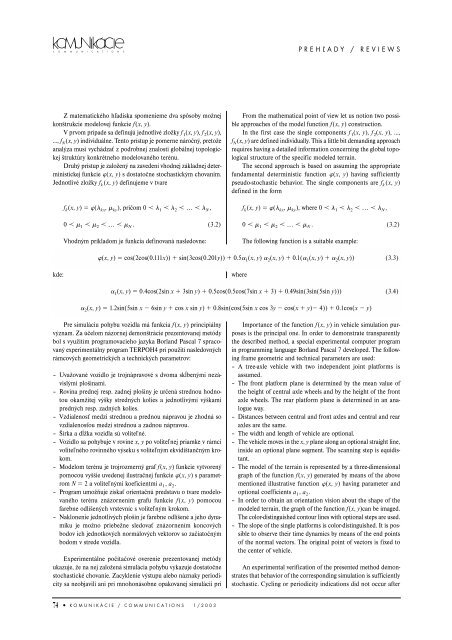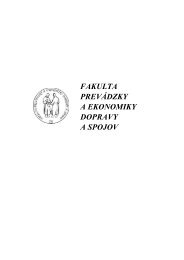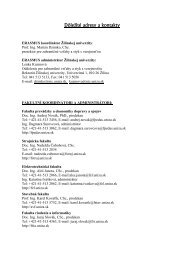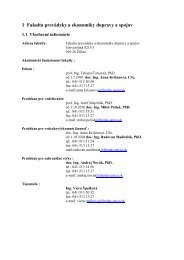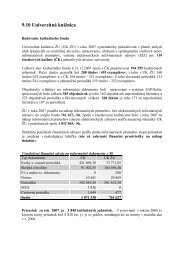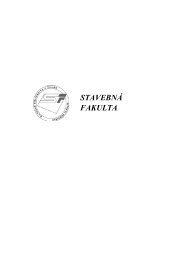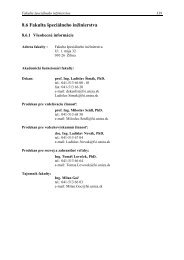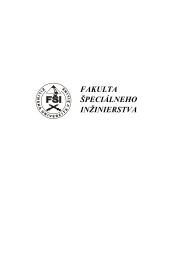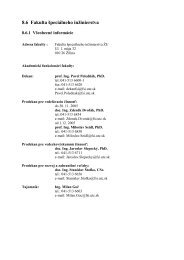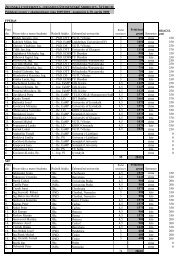posudzovanie vplyvu automobilovej dopravy na - Žilinská univerzita
posudzovanie vplyvu automobilovej dopravy na - Žilinská univerzita
posudzovanie vplyvu automobilovej dopravy na - Žilinská univerzita
You also want an ePaper? Increase the reach of your titles
YUMPU automatically turns print PDFs into web optimized ePapers that Google loves.
C O M M U N I C A T I O N S<br />
I S<br />
PREHĽADY / REVIEWS<br />
Z matematického hľadiska spomenieme dva spôsoby možnej<br />
konštrukcie modelovej funkcie f(x, y).<br />
V prvom prípade sa definujú jednotlivé zložky f 1 (x, y), f 2 (x, y),<br />
…, f N (x, y) individuálne. Tento prístup je pomerne náročný, pretože<br />
a<strong>na</strong>lýza musí vychádzať z podrobnej z<strong>na</strong>losti globálnej topologickej<br />
štruktúry konkrétneho modelovaného terénu.<br />
Druhý prístup je založený <strong>na</strong> zavedení vhodnej základnej deterministickej<br />
funkcie (x, y) s dostatočne stochastickým chovaním.<br />
Jednotlivé zložky f k (x, y) definujeme v tvare<br />
f k (x, y) ( kx , ky ), pričom 0 1 2 … N ,<br />
0 1 2 … N . (3.2)<br />
Vhodným príkladom je funkcia definovaná <strong>na</strong>sledovne:<br />
From the mathematical point of view let us notion two possible<br />
approaches of the model function f(x, y) construction.<br />
In the first case the single components f 1 (x, y), f 2 (x, y), …,<br />
f N (x, y) are defined individually. This a little bit demanding approach<br />
requires having a detailed information concerning the global topological<br />
structure of the specific modeled terrain.<br />
The second approach is based on assuming the appropriate<br />
fundamental deterministic function (x, y) having sufficiently<br />
pseudo-stochastic behavior. The single components are f k (x, y)<br />
defined in the form<br />
f k (x, y) ( kx , ky ), where 0 1 2 … N ,<br />
0 1 2 … N . (3.2)<br />
The following function is a suitable example:<br />
(x, y) cos(2cos(0.111x)) sin(3cos(0.201y)) 0.5 1 (x, y) 2 (x, y) 0.1( 1 (x, y) 2 (x, y)) (3.3)<br />
kde:<br />
where<br />
1 (x, y) 0.4cos(2sin x 3sin y) 0.5cos(0.5cos(7sin x 3) 0.49sin(3sin(5sin y))) (3.4)<br />
2 (x, y) 1.2sin(5sin x 6sin y cos x sin y) 0.8sin(cos(5sin x cos 3y cos(x y) 4)) 0.1cos(x y)<br />
Pre simuláciu pohybu vozidla má funkcia f(x, y) principiálny<br />
výz<strong>na</strong>m. Za účelom názornej demonštrácie prezentovanej metódy<br />
bol s využitím programovacieho jazyka Borland Pascal 7 spracovaný<br />
experimentálny program TERPOH4 pri použití <strong>na</strong>sledovných<br />
rámcových geometrických a technických parametrov:<br />
– Uvažované vozidlo je trojnápravové s dvoma skĺbenými nezávislými<br />
ploši<strong>na</strong>mi.<br />
– Rovi<strong>na</strong> prednej resp. zadnej plošiny je určená strednou hodnotou<br />
okamžitej výšky stredných kolies a jednotlivými výškami<br />
predných resp. zadných kolies.<br />
– Vzdialenosť medzi strednou a prednou nápravou je zhodná so<br />
vzdialenosťou medzi strednou a zadnou nápravou.<br />
– Šírka a dĺžka vozidla sú voliteľné.<br />
– Vozidlo sa pohybuje v rovine x, y po voliteľnej priamke v rámci<br />
voliteľného rovinného výseku s voliteľným ekvidištančným krokom.<br />
– Modelom terénu je trojrozmerný graf f(x, y) funkcie vytvorený<br />
pomocou vyššie uvedenej ilustračnej funkcie (x, y) s parametrom<br />
N 2 a voliteľnými koeficientmi a 1 , a 2 .<br />
– Program umožňuje získať orientačnú predstavu o tvare modelovaného<br />
terénu znázornením grafu funkcie f(x, y) pomocou<br />
farebne odlíšených vrstevníc s voliteľným krokom.<br />
– Naklonenie jednotlivých plošín je farebne odlíšené a jeho dy<strong>na</strong>miku<br />
je možno priebežne sledovať znázornením koncových<br />
bodov ich jednotkových normálových vektorov so začiatočným<br />
bodom v strede vozidla.<br />
Experimentálne počítačové overenie prezentovanej metódy<br />
ukazuje, že <strong>na</strong> nej založená simulácia pohybu vykazuje dostatočne<br />
stochastické chovanie. Zacyklenie výstupu alebo náz<strong>na</strong>ky periodicity<br />
sa neobjavili ani pri mnohonásobne opakovanej simulácii pri<br />
Importance of the function f(x, y) in vehicle simulation purposes<br />
is the principal one. In order to demonstrate transparently<br />
the described method, a special experimental computer program<br />
in programming language Borland Pascal 7 developed. The following<br />
frame geometric and technical parameters are used:<br />
– A tree-axle vehicle with two independent joint platforms is<br />
assumed.<br />
– The front platform plane is determined by the mean value of<br />
the height of central axle wheels and by the height of the front<br />
axle wheels. The rear platform plane is determined in an a<strong>na</strong>logue<br />
way.<br />
– Distances between central and front axles and central and rear<br />
axles are the same.<br />
– The width and length of vehicle are optio<strong>na</strong>l.<br />
– The vehicle moves in the x, y plane along an optio<strong>na</strong>l straight line,<br />
inside an optio<strong>na</strong>l plane segment. The scanning step is equidistant.<br />
– The model of the terrain is represented by a three-dimensio<strong>na</strong>l<br />
graph of the function f(x, y) generated by means of the above<br />
mentioned illustrative function (x, y) having parameter and<br />
optio<strong>na</strong>l coefficients a 1 , a 2 .<br />
– In order to obtain an orientation vision about the shape of the<br />
modeled terrain, the graph of the function f(x, y)can be imaged.<br />
The color-distinguished contour lines with optio<strong>na</strong>l steps are used.<br />
– The slope of the single platforms is color-distinguished. It is possible<br />
to observe their time dy<strong>na</strong>mics by means of the end points<br />
of the normal vectors. The origi<strong>na</strong>l point of vectors is fixed to<br />
the center of vehicle.<br />
An experimental verification of the presented method demonstrates<br />
that behavior of the corresponding simulation is sufficiently<br />
stochastic. Cycling or periodicity indications did not occur after<br />
74 ● KOMUNIKÁCIE / COMMUNICATIONS 1/2003


